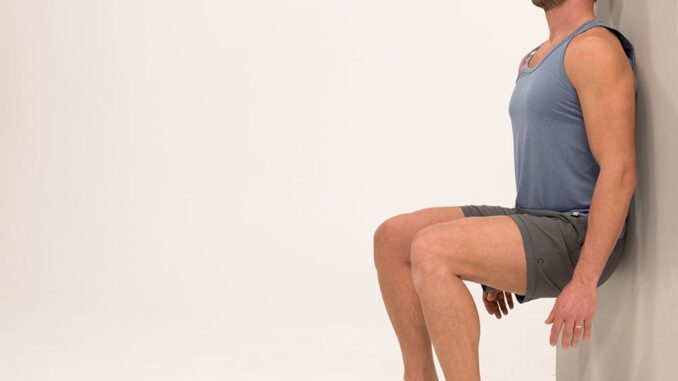
The wall sit is a simple yet effective exercise that targets multiple muscle groups, offering a range of benefits for strength, endurance, and overall fitness. In this extensive guide, we’ll explore the proper technique for performing a wall sit, delve into its various benefits, and provide tips for incorporating it into your fitness routine.
What is a Wall Sit?
A wall sit is an isometric exercise that primarily targets the muscles of the lower body, including the quadriceps, hamstrings, and glutes. It involves holding a seated position against a wall with the knees bent at a 90-degree angle, as if sitting in an invisible chair.
How to Perform a Wall Sit:
- Find a Wall: Start by finding a clear wall with enough space for you to sit comfortably.
- Position Yourself: Stand with your back against the wall, feet shoulder-width apart, and about 2 feet away from the wall.
- Lower Your Body: Slowly slide your back down the wall until your thighs are parallel to the ground, forming a 90-degree angle at the knees. Your knees should be directly above your ankles, and your back should be pressed firmly against the wall.
- Hold the Position: Maintain the seated position for as long as you can, aiming for 30 seconds to 1 minute or longer if possible. Focus on keeping your core engaged and your breathing steady throughout the exercise.
- Return to Standing: To exit the wall sit, slowly push yourself back up the wall using your legs until you are standing upright again.
Benefits of Wall Sits:
- Strengthens Leg Muscles: The wall sit primarily targets the quadriceps, hamstrings, and glutes, helping to build strength and endurance in these major muscle groups.
- Improves Core Stability: Maintaining proper form during a wall sit requires engagement of the core muscles, helping to improve stability and posture.
- Increases Lower Body Endurance: Holding the seated position for an extended period challenges the endurance of the leg muscles, leading to improved stamina and endurance over time.
- Requires Minimal Equipment: Wall sits can be performed virtually anywhere with access to a clear wall, making them a convenient exercise option for home workouts or while traveling.
- May Help Prevent Injury: Strengthening the muscles of the lower body through exercises like wall sits can help reduce the risk of injury during physical activity and everyday movements.
- Can Be Easily Modified: Wall sits can be modified to increase or decrease the intensity by adjusting the duration of the hold or incorporating variations such as single-leg wall sits or adding weights.
Tips for Performing Wall Sits:
- Focus on Form: Ensure that your knees are aligned with your ankles and your back is pressed firmly against the wall throughout the exercise to maintain proper form and maximize effectiveness.
- Start Slowly: If you’re new to wall sits, start with shorter hold times and gradually increase the duration as your strength and endurance improve.
- Listen to Your Body: Pay attention to any discomfort or strain during the exercise and stop if you experience pain. It’s normal to feel some muscle fatigue, but sharp or intense pain could indicate improper form or overexertion.
- Incorporate Variations: To add variety to your workout routine, try incorporating variations of the wall sit, such as pulsing movements, single-leg holds, or adding weights for added resistance.
- Combine with Other Exercises: For a comprehensive lower body workout, combine wall sits with other leg exercises such as squats, lunges, or calf raises to target different muscle groups and maximize results.
In conclusion, the wall sit is a versatile and effective exercise that offers numerous benefits for strength, endurance, and overall fitness. By mastering proper technique and incorporating wall sits into your regular workout routine, you can strengthen your lower body muscles, improve core stability, and enhance your overall physical performance. So, find a clear wall, get into position, and start reaping the rewards of this simple yet powerful exercise.